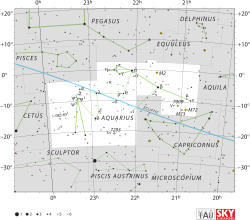| Observation data Epoch J2000 Equinox J2000 | |
|---|---|
| Constellation | Aquarius |
| Right ascension | 22h 26m 34.2753s[1] |
| Declination | –16° 44′ 31.697″[1] |
| Apparent magnitude (V) | 5.56[2] (6.35/6.57)[3] |
| Characteristics | |
| Spectral type | G1 V + G5 V Fe–0.8 CH–1[4] |
| U−B color index | +0.09[2] |
| B−V color index | +0.61[2] |
| Astrometry | |
| Radial velocity (Rv) | +2.1[5] km/s |
| Proper motion (μ) | RA: +200.59[1] mas/yr Dec.: +14.51[1] mas/yr |
| Parallax (π) | 49.50 ± 1.23 mas[1] |
| Distance | 66 ± 2 ly (20.2 ± 0.5 pc) |
| Absolute magnitude (MV) | 4.05[5] (4.94/4.87)[3] |
| Orbit[6] | |
| Primary | 53 Aqr A |
| Companion | 53 Aqr B |
| Period (P) | 3500 yr |
| Semi-major axis (a) | 14.88″ |
| Eccentricity (e) | 0.90 |
| Inclination (i) | 44.13° |
| Longitude of the node (Ω) | 294.55° |
| Periastron epoch (T) | B 2023 |
| Argument of periastron (ω) (secondary) | 151.40° |
| Details | |
| 53 Aqr A | |
| Mass | 1.01[7] M☉ |
| Radius | 1.11[8] R☉ |
| Luminosity | 1.39[8] L☉ |
| Surface gravity (log g) | 4.46[3] cgs |
| Temperature | 5,922[3] K |
| Metallicity [Fe/H] | –0.10[3] dex |
| Rotational velocity (v sin i) | 8[9] km/s |
| Age | 0.18–0.37[10] Gyr |
| 53 Aqr B | |
| Mass | 0.99[7] M☉ |
| Surface gravity (log g) | 4.44[3] cgs |
| Temperature | 5,811[3] K |
| Metallicity [Fe/H] | –0.19[3] dex |
| Rotational velocity (v sin i) | 9[9] km/s |
| Other designations | |
| 53 Aqr A: BD–17 6521, HD 212698, HR 8545, LTT 9026, SAO 165078. | |
| 53 Aqr B: BD–17 6520, HD 212697, HR 8544, LTT 9025, SAO 165077. | |
| Database references | |
| SIMBAD | 53 Aqr |
| 53 Aqr A | |
| 53 Aqr B | |
53 Aquarii (abbreviated 53 Aqr) is a binary star[12] system in the equatorial constellation of Aquarius. 53 Aquarii is its Flamsteed designation though the star also bears the Bayer designation of f Aquarii. The combined apparent visual magnitude of the pair is a 5.56,[2] making it just visible to the naked eye in dark suburban skies. Based upon an annual parallax shift of 49.50 milliarcseconds for the first component, this system is located at a distance of approximately 65 light-years (20 parsecs) from Earth.[1]
This is a wide binary star system with a projected separation of 100 astronomical units; indicating that the two stars are at least this distance apart.[8] The primary component is a solar-type main sequence star with a stellar classification of G1 V.[4] It has about 99% of the Sun's mass, 111% of the Sun's radius, and shines with 139% of the luminosity of the Sun.[8] This energy is being emitted from an outer envelope at an effective temperature of 5,922 K,[3] giving it the golden hue of a G-type star.[13] An examination of the primary component with the Spitzer Space Telescope failed to detect any infrared excess that might otherwise be an indication of a circumstellar debris disk.[8]
The companion is a slightly cooler star with an effective temperature of 5,811 K.[3] It has a stellar classification of G5 V Fe–0.8 CH–1,[4] indicating it is a chemically peculiar G-type main sequence star showing an under-abundance of iron and the molecule CH in its spectrum. As of 2008, it has an angular separation of 1.325 arcseconds along a position angle of 30.9° from the primary.[14]
This system is coeval with the Castor Moving Group of stars that share a common motion through space; hence it is a candidate member of that association. This suggests that the system is young; its estimated age is in the range of 180 to 370 million years, based upon the spectrum and X-ray luminosity, respectively.[10]
- ^ a b c d e f Cite error: The named reference
aaa474_2_653was invoked but never defined (see the help page). - ^ a b c d Cite error: The named reference
aass34_1was invoked but never defined (see the help page). - ^ a b c d e f g h i j Cite error: The named reference
aaa287_1_191was invoked but never defined (see the help page). - ^ a b c Cite error: The named reference
aj132_1_161was invoked but never defined (see the help page). - ^ a b Cite error: The named reference
aaa418_989was invoked but never defined (see the help page). - ^ "Sixth Catalog of Orbits of Visual Binary Stars". United States Naval Observatory. Archived from the original on 1 August 2017. Retrieved 3 June 2017.
- ^ a b Cvetkovic, Z.; Ninkovic, S. (2010). "On the Component Masses of Visual Binaries". Serbian Astronomical Journal. 180 (180): 71–80. Bibcode:2010SerAJ.180...71C. doi:10.2298/SAJ1080071C.
- ^ a b c d e Cite error: The named reference
apj698_2_1068was invoked but never defined (see the help page). - ^ a b Cite error: The named reference
aaa460_3_695was invoked but never defined (see the help page). - ^ a b Cite error: The named reference
aaa521_A12was invoked but never defined (see the help page). - ^ Cite error: The named reference
SIMBADwas invoked but never defined (see the help page). - ^ Cite error: The named reference
mnras389_2_869was invoked but never defined (see the help page). - ^ Cite error: The named reference
csirowas invoked but never defined (see the help page). - ^ Cite error: The named reference
pasp120_864_170was invoked but never defined (see the help page).
